Military Regions of Laos
The Kingdom of Laos was divided into Military Regions, beginning in 1955. The Military Regions were necessitated by the poor lines of communication within the country. The Military Districts were the basis of a culture of war lordism in the Royal Lao Armed Forces high command.
Overall
Laos covers approximately 235,000 square kilometers (91,000 square miles). In the early 1950s, there were few means of transportation available in the Kingdom of Laos. Travel by riverboat was the most reliable means of travel in country. Laos, newly independent from the French, had bequeathed fewer than 1,500 kilometers of all-season road. The purpose of French colonial roadbuilding had not been the interconnection of Laos, but rather linkage with Vietnam. Air transportation in Laos depended on half a dozen airports that could accommodate nothing larger than twin engine aircraft. With such poor lines of communication, defense of the country was entrusted to troops raised in and stationed in Military Regions. As a result of this decentralized organization, the General Staff in Vientiane primarily served an administrative function. Consequently, Lao commanders of Military Regions became war lords within their regions.[1][2][3] A top command position within a Military Region was dependent upon the urban elite family or families who economically and politically dominated the MR. If a general was not a scion of one of these families, then he had their support in some other manner.[4]
Military Region 1
The provinces of Military Region 1 are listed and mapped below. It was headquartered at Luang Prabang. Its original appointee to command it in 1955 was Major (later General) Ouane Rattikone.[1]
In late 1962, MR 1 was commanded by Colonel Sourith Don Sasorith.[5]
| Location | Name | Capital | Area (km²) | Remarks |
|---|---|---|---|---|
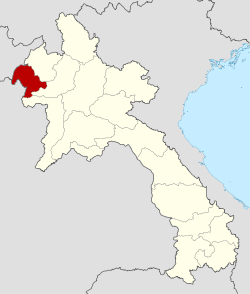 |
Bokèo Province |
Houayxay District (Ban Houayxay) |
4,970 | |
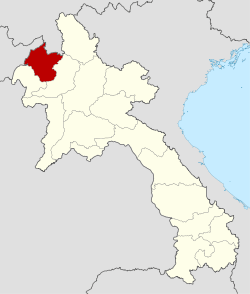 |
Luang Namtha Province |
Namtha District (Luang Namtha) |
9,325 | |
 |
Louangphabang Province |
Louangphrabang District (Luang Prabang) |
16,875 | Luang Prabang city was MR headquarters |
 |
Oudômxai Province |
Xay District (Muang Xay) |
15,370 | |
 |
Phôngsali Province |
Phongsaly District (Phongsali) |
16,270 | |
 |
Xaignabouli Province |
Xayabury District (Sainyabuli) |
11,795[6] | Became Military Region 6 from early 1962 through July 1968 |
Military Region 2
The provinces of Military Region 2 are mapped and listed below. Its original military commander in 1955 was Major (later General) Sang Kittarath.[7]
In mid 1962, Colonel Khamkong Bouddavong appointed the MR 2 commander.[8]
| Location | Name | Capital | Area (km²) | Remarks |
|---|---|---|---|---|
 |
Bolikhamxai Province |
Paksane District (Pakxan) |
16,470 | |
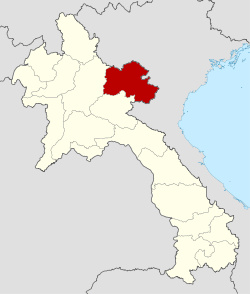 |
Houaphan Province |
Xamneua District (Xam Neua) |
16,500 | |
 |
Vientiane Province | Vientiane Prefecture (also national administrative capital) | 19,847 | City of Vientiane both national and Military Region 5 headquarters |
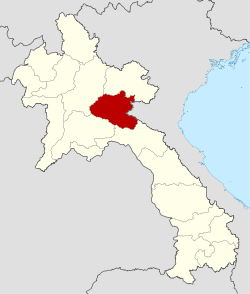 |
Xiangkhouang Province |
Pek District (Phonsavan) |
15,880[6] |
Military Region 3
The provinces of Military Region 3 are mapped and listed below. Its original commanding officer in 1955 was Major (later General) Sing Rattanasamy.[7]
In late 1962, the MR 3 commander was Colonel Lam Ngeum.[9]
On 1 July 1971, Colonel Nouphet Daoheuang took command.[10]
| Location | Name | Capital | Area (km²) | Remarks |
|---|---|---|---|---|
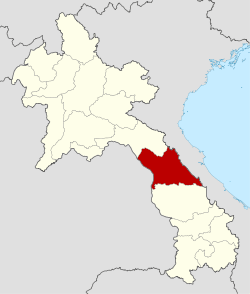 |
Khammouan Province |
Thakhek District (Thakhek) |
16,315 | |
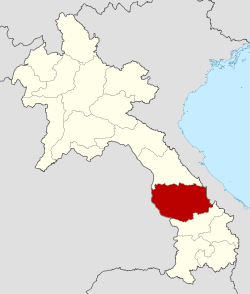 |
Savannakhét Province | Khanthabouly District (Savannakhet) |
21,774[6] | |
Military Region 4
The provinces of Military Region 4 are mapped and listed below. Its original commander in 1955 was Major (later General) Amkha Soukhavong.[11]
In late 1962, the MR 4 commander was Colonel Phasouk Somly Rasphakdi.[12]
| Location | Name | Capital | Area (km²) | Remarks |
|---|---|---|---|---|
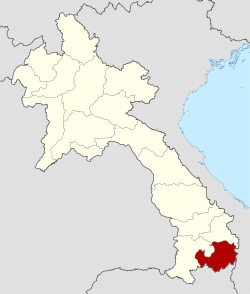 |
Attapu Province |
Samakkhixay District (Attapeu) |
10,320 | |
 |
Champasak Province |
Pakse District (Pakse) |
15,415 | Became Military Region 7 from early 1962 until July 1968 |
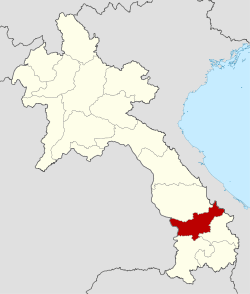 |
Salavan Province |
Salavan District (Salavan) |
10,691 | |
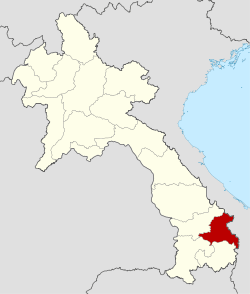 |
Xékong Province |
Lamarm District (Sekong) |
7,665[6] | |
Military Region 5
Military Region 5 was formed in Summer 1959. It contained Vientiane Province, including Vientiane Prefecture. Its first commanding officer was General Phoumi Nosavan.[13]
In early 1960, Colonel Kouprasith Abhay was appointed the MR 5 commander.[14]
On 1 July 1971, General Thonglith Chokbengboun took command.[15]
Military Region 6
Sainyabuli Province was removed from MR 1 in early 1962, and designated as MR 6.[16] It was returned to MR 1 in July 1968.[17]
In late 1962, MR 6 was commanded by Colonel Houmphanh Norasing.[18]
Military Region 7
Champasac Province was designated as MR 7 in early 1962.[16] It was returned to Military Region 4 in July 1968.[17]
In late 1962, MR 7 was commanded by Colonel Kot Venevongsos.[9]
Endnotes
- ↑ 1.0 1.1 Conboy, Morrison, p. 14.
- ↑ Fall, p. 17.
- ↑ Anthony, Sexton, p. 5.
- ↑ Anthony, Sexton, p. 70 n 47.
- ↑ Conboy, Morrison, pp. 95, 451.
- ↑ 6.0 6.1 6.2 6.3 Statoids website at http://www.statoids.com/ula.html is the source for all geographic data. Retrieved 14 March 2015.
- ↑ 7.0 7.1 Conboy, Morrison, pp. 14, 451.
- ↑ Conboy, Morrison, p. 19.
- ↑ 9.0 9.1 Conboy, Morrison, pp. 95, 448.
- ↑ Conboy, Morrison, p. 371.
- ↑ Conboy, Morrison, pp. 14, 445.
- ↑ Conboy, Morrison, pp. 95, 450
- ↑ Conboy, Morrison, p. 25.
- ↑ Conboy, Morrison, p. 45 note 7, p. 46 note 30.
- ↑ Conboy, Morrison, pp. 370, 452.
- ↑ 16.0 16.1 Conboy, Morrison, p. 70.
- ↑ 17.0 17.1 Conboy, Morrison, p. 200.
- ↑ Conboy, Morrison, pp. 95, 447.
References
- Anthony, Victor B. and Richard R. Sexton (1993). The War in Northern Laos. Command for Air Force History. OCLC 232549943.
- Conboy, Kenneth and James Morrison (1995). Shadow War: The CIA's Secret War in Laos. Paladin Press. ISBN 0-87364-825-0.
- Fall, Bernard (1969). Anatomy of a Crisis: The Laotian Crisis of 1960–1961. Doubleday & Co. ASIN: B00JKPAJI4.
Further reading
- Diller, Richard (2013). Firefly: A Skyraider's Story about America's Secret War Over Laos. Dogear Publishing. ISBNs 1-45751-969-0, 978-145751-969-7.
- Lerner, Joe (2006). In the Black. iUniverse. ISBNs 0-59540-714-5, 978-0-595-40714-9.
- Polifka, Karl (2013). Meeting Steve Canyon: ...and Flying with the CIA in Laos. CreateSpace. ISBNs 1-49097-985-9, 978-1-49097-985-4.
- Webb, Billy G. (2010). Secret War. XLibris. ISBNs 1-45356-485-3, 978-1-45356-485-1.